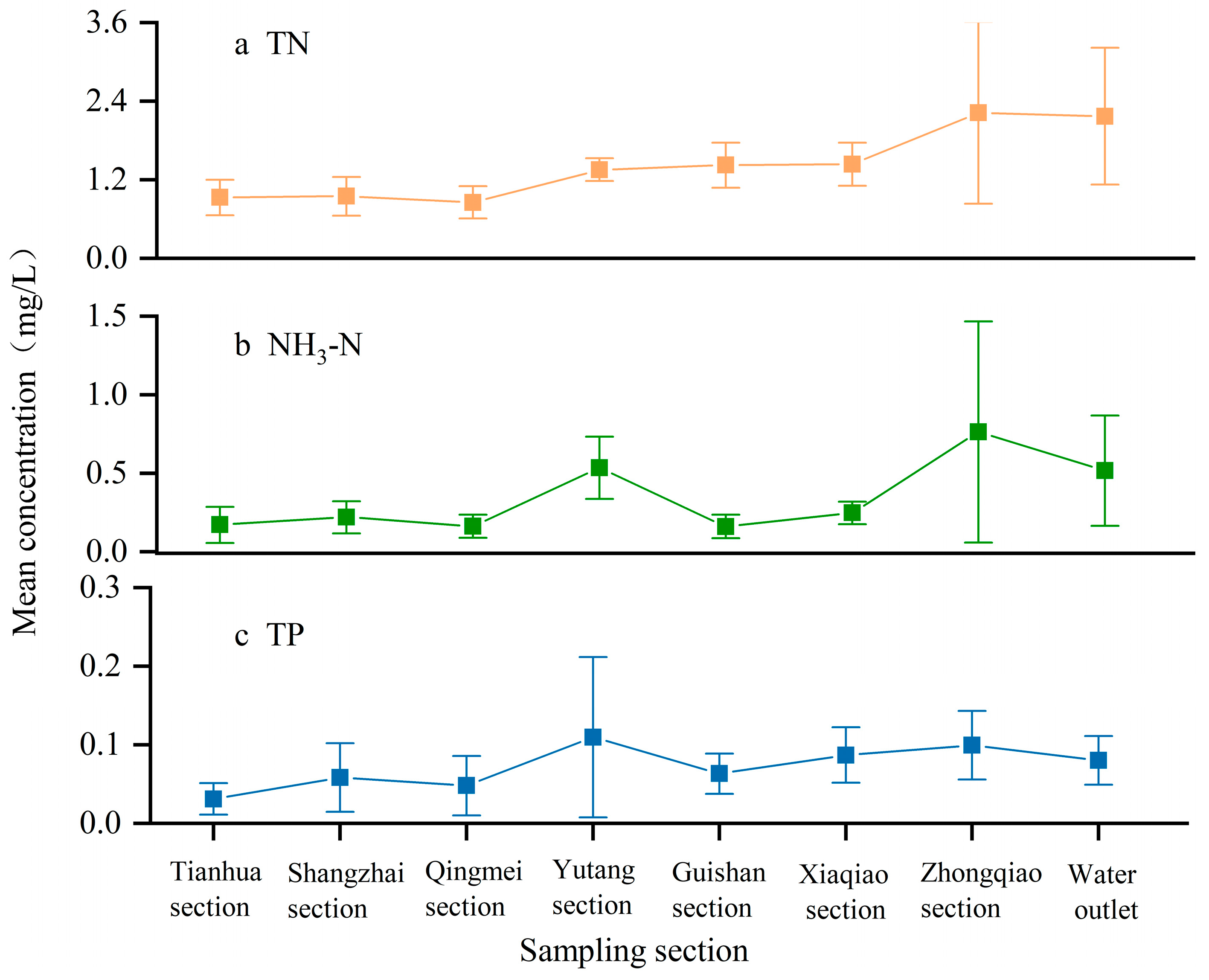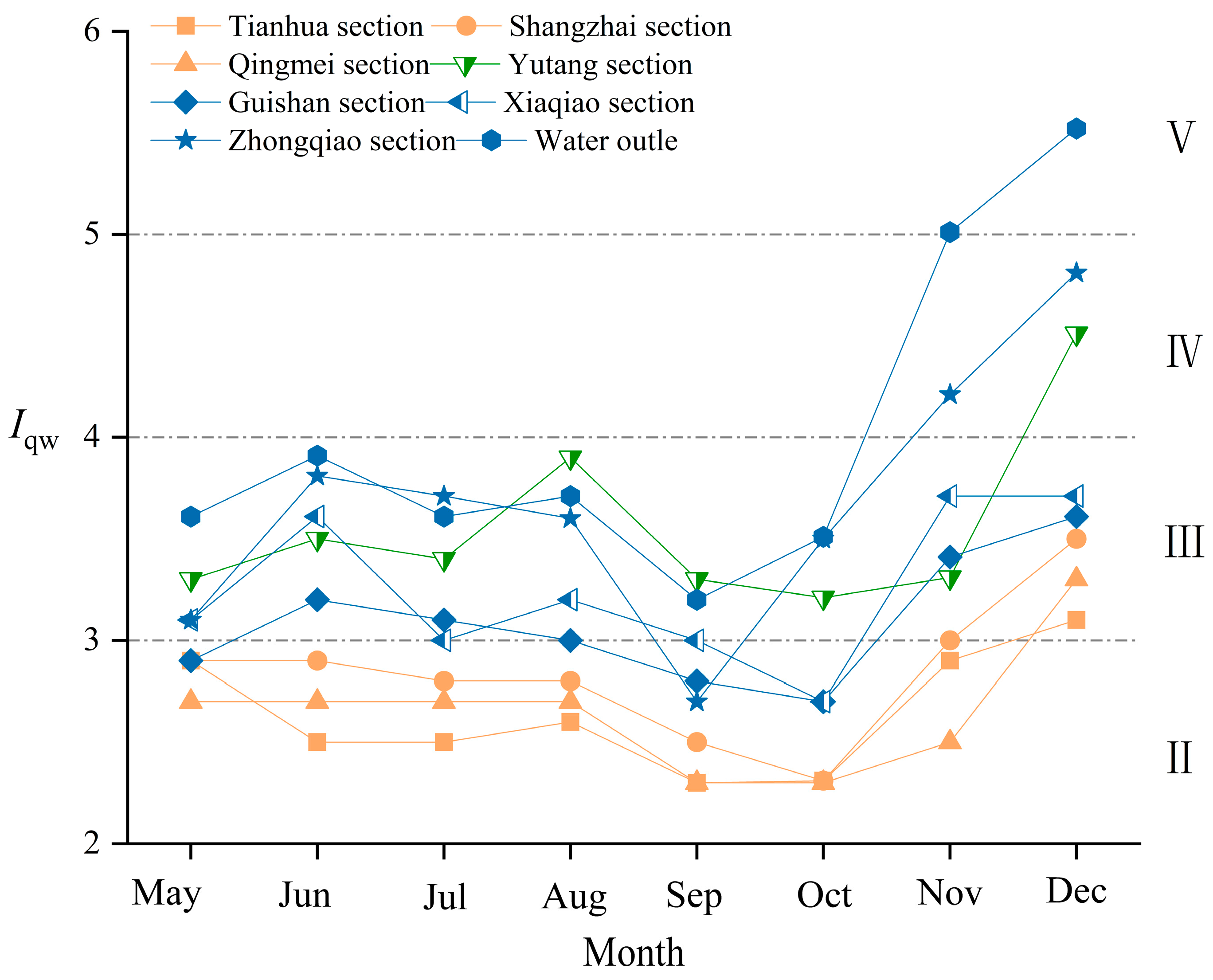Nitrogen and Phosphorus Pollution Discharge and Water Quality Evaluation in a Small Basin of the Upper Reaches of Lijiang River
Abstract
:1. Introduction
2. Materials and Methods
2.1. Overview of the Study Area
2.2. Sample Layout and Data Collection
2.3. Calculation of Nitrogen and Phosphorus Discharge Load
2.4. Water Quality Evaluation
3. Results and Discussion
3.1. Temporal Variation in Nitrogen and Phosphorus Concentrations
3.2. Changes in Nitrogen and Phosphorus Concentrations along the River Course
3.3. Temporal Variation in Nitrogen and Phosphorus Discharge Loads
3.4. Spatial Characteristics of Nitrogen and Phosphorus Discharge Loads
3.5. Changes in Comprehensive River Water Quality
4. Conclusions
Author Contributions
Funding
Data Availability Statement
Acknowledgments
Conflicts of Interest
References
- Loague, K.; Corwin, D.L.; Ellsworth, A.T.R. Feature: The challenge of predicting nonpoint source pollution. Environ. Sci. Technol. 1998, 32, 130–133. [Google Scholar] [CrossRef] [PubMed]
- Liu, R.M.; Xu, F.; Zhang, P.P.; Yu, W.W.; Men, C. Identifying non-point source critical source areas based on multi-factors at a basin scale with SWAT. J. Hydrol. 2016, 533, 379–388. [Google Scholar] [CrossRef]
- Liang, L.; Wang, J.; Yan, Y.C. Evaluating nitrogen management of farm systems in the steep-mountainous KARST region. Am.-Eurasian J. Sustain. Agric. 2008, 2, 180–186. [Google Scholar]
- Ongley, E.D.; Zhang, X.L.; Tao, Y. Current status of agricultural and rural non-point source Pollution assessment in China. Environ. Pollut. 2010, 158, 1159–1168. [Google Scholar] [CrossRef] [PubMed]
- Xu, J.; Yin, W.; Ai, L.; Xin, X.; Shi, Z. Spatiotemporal patterns of non-point source nitrogen loss in an agricultural catchment. Water Sci. Eng. 2016, 9, 125–133. [Google Scholar] [CrossRef]
- Wang, X.; Hao, F.H.; Cheng, H.G.; Yang, S.T.; Zhang, X.; Bu, Q.S. Estimating non-point source pollutant loads for the large-scale basin of the Yangtze River in China. Environ. Earth Sci. 2011, 63, 1079–1092. [Google Scholar] [CrossRef]
- Yu, F.; Shi, W.M. Non-point Source Pollution Research in China and Aboard Based on Bibliometrics. Chin. Agric. Sci. Bull. 2014, 30, 242–248. (In Chinese) [Google Scholar]
- Nikolaidis, N.P.; Heng, H.; Semagin, R.; Clausen, J.C. Non-linear response of a mixed land use watershed to nitrogen loading. Agric. Ecosyst. Environ. 1998, 67, 251–265. [Google Scholar] [CrossRef]
- Liu, R.M.; Zhang, P.P.; Wang, X.J.; Chen, Y.X.; Shen, Z.Y. Assessment of effects of best management practices on agricultural non-point source pollution in Xiangxi River watershed. Agric. Water Manag. 2013, 117, 9–18. [Google Scholar] [CrossRef]
- Cheng, G.W.; Wang, D.Q. The water problems and control countermeasures of Lijiang River. Carsologica Sin. 1998, 4, 351–356. (In Chinese) [Google Scholar]
- Ye, G.Z.; Liu, J. Water environmental capacity of Guilin section of Lijiang River. Water Resour. Prot. 2003, 9, 10–12. (In Chinese) [Google Scholar]
- Xu, Z.F.; Li, J.C.; Mo, D.Q.; Li, W.W.; Qiu, M.D.; Huang, L.F.; Liu, S.L.; Lu, Q.L. Study on the present state of rural water pollution in Li River Valley and comprehensive treatment. Environ. Sci. Technol. 2010, s2, 644–646. (In Chinese) [Google Scholar]
- Xue, B.M.; Wang, Y.H.; Zhang, D.; Zhang, J.L.; Leng, B.; Huang, W.Y.; Chen, Z.H. Concentration, distribution and sources of polycyclic aromatic hydrocarbons (PAHs) in surface sediments from Lijiang River, South China. Bull. Environ. Contam. Toxicol. 2013, 90, 446–450. [Google Scholar] [CrossRef] [PubMed]
- Zhang, L.H.; Dai, J.F.; Mo, L.X.; Su, Y.J.; Zeng, H.H. Effects of different underlying conditions on nitrogen and phosphorus pollution load in small watershed of Lijiang River. Water Sav. Irrig. 2018, 2, 66–70. (In Chinese) [Google Scholar]
- Zhang, L.H. Non-point source pollution in the small watershed of Jingui River in the upper reaches of Lijiang River. Master’s Thesis, Guilin University of Technology, Guilin, China, 2018. (In Chinese). [Google Scholar]
- Lin, P.; Chen, Y.D.; Xia, Y. Types and causes of water pollution under different land use types in Lijiang River Basin. J. Guilin Univ. Technol. 2016, 36, 539–544. (In Chinese) [Google Scholar]
- Yang, L.Y.; Xia, Y. Analysis and reduction strategies of non-point source pollution in small watershed of Lijiang tributaries. J. Guilin Univ. Technol. 2017, 37, 177–181. (In Chinese) [Google Scholar]
- Shen, H.Y.; Jiang, G.H.; Guo, F.; Guo, X.J. Distribution characteristics and influence factors of the ammonia, nitrite and nitrate in the Lijiang River, Guilin City. Carsologica Sin. 2015, 34, 369–374. (In Chinese) [Google Scholar]
- Miao, Y.; Zhang, C.; Xiao, Q.; Zhao, H.J.; Li, C.X. Dynamic variations and sources of nitrate during dry season in the Lijiang River. Environ. Sci. 2018, 39, 1589–1597. (In Chinese) [Google Scholar]
- Grizzetti, B.; Bouraoui, F.; Granlund, K.; Rekolainen, S.; Bidoglio, G. Modelling diffuse emission and retention of nutrients in the Vantaanjoki watershed (Finland) using the SWAT model. Ecol. Model. 2003, 169, 25–38. [Google Scholar] [CrossRef]
- Jayakrishnan, R.; Srinivasan, R.; Santhi, C.; Arnold, J.G. Advances in the application of the swat model for water resources management. Hydrol. Process. 2005, 19, 749–762. [Google Scholar] [CrossRef]
- Xu, Z.X. Comprehensive water quality identification index for environmental quality assessment of surface water. J. Tongji Univ. (Nat. Sci. Ed.) 2005, 33, 482–488. (In Chinese) [Google Scholar]
- Xu, Z.X. Single factor water quality identification index for environmental quality assessment of surface water. J. Tongji Univ. (Nat. Sci. Ed.) 2005, 33, 321–325. (In Chinese) [Google Scholar]
- Bhatt, H.A.; Karanjekar, V.R.; Altouqi, S.; Sattler, M.L.; Hossain, S.; Chen, V.P. Estimating landfill leachate BOD and COD based on rainfall, ambient temperature, and waste composition: Exploration of a MARS statistical approach. Environ. Technol. Innov. 2017, 8, 1–16. [Google Scholar] [CrossRef]
- Wu, W.N. Practical application analysis of high-quality and high-yield rice cultivation techniques. Agric. Technol. 2018, 38, 108–109. (In Chinese) [Google Scholar]
- Bora, M.; Goswami, C.D. Water quality assessment in terms of water quality index (WQI): Case study of the Kolong River, Assam, India. Appl. Water Sci. 2017, 7, 3125–3135. [Google Scholar] [CrossRef]
- Guo, M.; Zhang, T.; Li, J.; Li, Z.; Xu, G.; Yang, R. Reducing Nitrogen and Phosphorus Losses from Different Crop Types in the Water Source Area of the Danjiang River, China. Int. J. Environ. Res. Public Health 2019, 16, 3442. [Google Scholar] [CrossRef] [PubMed]
- Zhou, Z.M.; Chen, C.S.; Liu, K.H.; Li, J.; Chen, M.L.; Jiang, Y.; Yu, F.M. Phytoplankton community and water quality in Guilin City section of Lijiang River in summer, China. Ecol. Environ. Sci. 2014, 4, 649–656. (In Chinese) [Google Scholar]
- Yu, X.X.; Yang, G.H.; Liang, T. Effects of land use on nitrogen runoff loss process in Xitiaoxi watershed. Agric. Environ. Prot. 2002, 21, 424–427. (In Chinese) [Google Scholar]
- Steinhoff-Wrześniewska, A.; Strzelczyk, M.; Helis, M.; Paszkiewicz-Jasińska, A.; Gruss, Ł.; Pulikowski, K.; Skorulski, W. Identification of catchment areas with nitrogen pollution risk for lowland river water quality. Arch. Environ. Prot. 2022, 48, 53–64. [Google Scholar] [CrossRef]
- Ren, C.X.; Peng, D.M.; Shi, X.Y.; Yang, S.; Zhang, P.; Zhang, J.B. Seasonal Total Nitrogen and Phosphorus Variation, Speciation, and Composition in the Maowei Sea Affected by Riverine Flux Input, South China Sea. Water 2022, 14, 2584. [Google Scholar] [CrossRef]
- Han, X.; Pan, B.Z.; Chen, Y. Characteristics of water environment and spatial-temporal distribution of nitrogen and phosphorus loads in the Yellow River. Environ. Sci. 2021, 42, 5786–5795. (In Chinese) [Google Scholar]
- Liu, F.P. Analysis of the impact of paddy field water and fertilizer management on the emission of agricultural non-point source pollution at different scales. Jiangxi Agric. J. 2016, 28, 105–109. [Google Scholar] [CrossRef]
- Cui, Y.L. Research and Application of Comprehensive Technology of Water Saving, Yield Increasing, High Efficiency and Pollution Reduction in Rice Irrigation Area. Master’s Thesis, Wuhan University, Hubei, China, 2010. (In Chinese). [Google Scholar]
- Aoubid, S.H.; Opp, C. Nitrogen and Phosphorus Discharge Loads Assessment Using the SWAT Model: A Case Study of the Shatt Al-Arab River Basin. Appl. Sci. 2023, 13, 8376. [Google Scholar] [CrossRef]
- Mutema, M.; Chaplot, V.; Jewitt, G.; Chivenge, P.; Bloschl, G. Annual water, sediment, nutrient, and organic carbon fluxes in river basins: A global meta-analysis as a function of scale. Water Resour. Res. 2015, 51, 8949–8972. [Google Scholar] [CrossRef]
- Chen, M.Y.; Cui, Y.L.; Zheng, S.Z.; Yang, B.L.; Zhao, S.J. Scale effect of agricultural non-point source pollution based on SWAT model. Rural. Water Conserv. Hydropower China 2016, 187–191+196. (In Chinese) [Google Scholar]
- Cheng, Y.; Chen, J.J.; Xie, X.; Zhang, X.Y.; Liu, K.; Dai, J.; Zhang, C. Research progress on nitrogen and phosphorus pollution characteristics and migration and transformation of mulberry fish pond subsystem. Guangdong Agric. Sci. 2021, 48, 74–87. (In Chinese) [Google Scholar]
- Zhang, X.D.; Han, X.; Sun, C.S. Effects of land use on water quality at different spatial and temporal scales in Wuding River and Yanhe River Basin. Environ. Sci. 2023, 54, 29–34. [Google Scholar] [CrossRef]
- Tang, L.; Hu, X.H. Spatial and temporal distribution characteristics of water quality in Tanjiang River Basin and its correlation with land use. Earth Environ. 2018, 46, 364–372. (In Chinese) [Google Scholar] [CrossRef]
- Gossweiler, B.; Wesström, I.; Messing, I.; Romero, A.M.; Joel, A. Spatial and Temporal Variations in Water Quality and Land Use in a Semi-Arid Catchment in Bolivia. Water 2019, 11, 2227. [Google Scholar] [CrossRef]
- Orzepowski, W.; Paruch, A.; Pulikowski, K.; Kowalczyk, T.; Pokładek, R. Quantitative and qualitative assessment of agricultural water resources under variable climatic conditions of Silesian Lowlands (Southwest Poland). Agric. Water Manag. 2014, 138, 45–54. [Google Scholar] [CrossRef]







| Reach | Sub-Basin | Sampling Section | Lat & Long | Land Use Type |
|---|---|---|---|---|
| Upper reaches | 1st | Tianhua section | 110.185 E, 25.354 N | Paddy field, orchard, woodland |
| Shangzhai section | 110.189 E, 25.354 N | |||
| Qingmei section | 110.191 E, 25.342 N | |||
| Middle reaches | 3rd | Yutang section | 110.190 E, 25.340 N | Paddy field, woodland, grassland, fish pond |
| Lower reaches | 9th | Guishan section | 110.196 E, 25.325 N | Paddy field, grassland, village and town |
| Xiaqiao section | 110.195 E, 25.311 N | |||
| 11th | Zhongqiao section | 110.221 E, 25.309 N | Grassland, woodland, paddy field | |
| Water outlet | 110.228 E, 5.306 N |
Disclaimer/Publisher’s Note: The statements, opinions and data contained in all publications are solely those of the individual author(s) and contributor(s) and not of MDPI and/or the editor(s). MDPI and/or the editor(s) disclaim responsibility for any injury to people or property resulting from any ideas, methods, instructions or products referred to in the content. |
© 2023 by the authors. Licensee MDPI, Basel, Switzerland. This article is an open access article distributed under the terms and conditions of the Creative Commons Attribution (CC BY) license (https://creativecommons.org/licenses/by/4.0/).
Share and Cite
Yu, J.; Mo, L.; Dai, J.; Bai, K.; Mo, J.; Zhang, S. Nitrogen and Phosphorus Pollution Discharge and Water Quality Evaluation in a Small Basin of the Upper Reaches of Lijiang River. Water 2024, 16, 104. https://doi.org/10.3390/w16010104
Yu J, Mo L, Dai J, Bai K, Mo J, Zhang S. Nitrogen and Phosphorus Pollution Discharge and Water Quality Evaluation in a Small Basin of the Upper Reaches of Lijiang River. Water. 2024; 16(1):104. https://doi.org/10.3390/w16010104
Chicago/Turabian StyleYu, Jianzhou, Leixin Mo, Junfeng Dai, Kaihua Bai, Jianying Mo, and Shuaipu Zhang. 2024. "Nitrogen and Phosphorus Pollution Discharge and Water Quality Evaluation in a Small Basin of the Upper Reaches of Lijiang River" Water 16, no. 1: 104. https://doi.org/10.3390/w16010104
APA StyleYu, J., Mo, L., Dai, J., Bai, K., Mo, J., & Zhang, S. (2024). Nitrogen and Phosphorus Pollution Discharge and Water Quality Evaluation in a Small Basin of the Upper Reaches of Lijiang River. Water, 16(1), 104. https://doi.org/10.3390/w16010104





